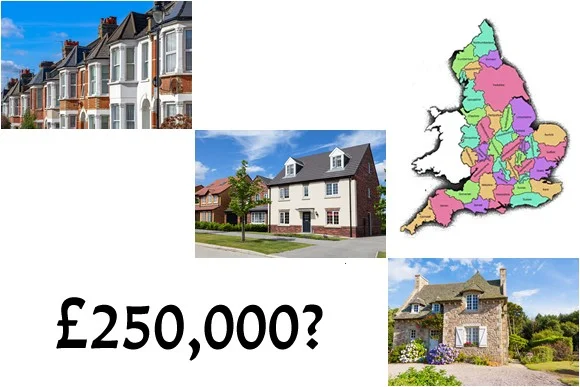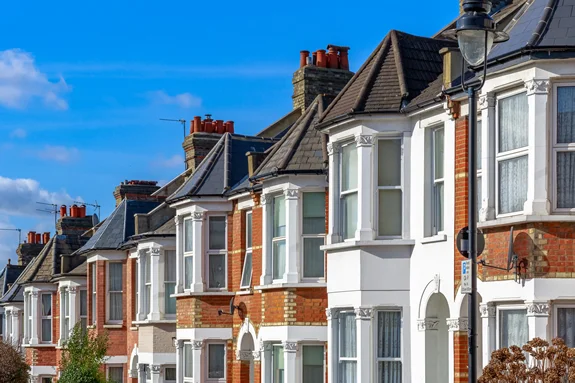What £250,000 Will Stretch to in Several Areas of England
Average property prices in the UK exceeded £250,000 some time ago, but what exactly can you get for this kind of money in different corners of the country?
Unsurprisingly, the size and specification of property you can expect for your £250,000 differ greatly from one region to the next. With the stamp duty holiday having been extended until at least September 30, the next few months are expected to be particularly busy for the real estate market.
For those setting their sights on a property for around the £250,000 national average, this is what you are likely to find available in key areas of England:
North East
The average price for a three-bedroom house in the north-east of England is just over £152,000, which means that £250,000 would stretch to quite an impressive property. An attractive four-bedroom townhouse recently renovated and with pristine private gardens should be well within your price bracket in select areas of the North East.
North West
Similarly, the average market value of a three-bedroom home in the north-west of England is just under £200,000. If you are looking to spend £250,000, you could invest in a large and relatively newly built four-bedroom home with landscaped gardens, a separate dining room, and excellent transport connections. House prices are also up more than 7% in this region year-on-year, making it a great location to consider buying into.
Yorkshire and the Humber
With average prices hovering around £190,000, an investment of £250,000 in Yorkshire and the Humber could stretch to a beautiful rural property in a quiet and secluded corner of the county. Ideal for those looking to escape the chaos and congestion of busy urban centres for a more tranquil countryside lifestyle.
West Midlands
Homes rarely take much time to sell in the West Midlands, an average of 65 days, fuelled by consistent demand. £250,000 in an area where the average property values hover around £220,000 could easily stretch to a spacious three-bedroom semi in a desirable corner of the county with lush gardens and an expansive driveway for multiple cars.
East of England
Property prices in this region are currently averaging around £327,000, though there is plenty available for a £250,000 investment. Three-bedroom detached and semi-detached properties in and around Norwich in particular are proving popular among movers and investors alike.
South East
With the same average asking price of around £372,000, the second-most expensive region in England still has options available for a £250,000 investment. Terraced properties, in particular those with private gardens and two to three bedrooms, were in plentiful supply as of early 2021.
London
Lastly, £250,000 is still more than enough to invest in an attractive contemporary flat with two bedrooms and spacious living areas in several South London postcodes. Considering the average price of around £645,000 for a home in London, the fact that anything attractive is available for this kind of money is actually quite surprising.
A Central Knightsbridge Flat for Just £150,000?
We recently published a post examining what the average UK house price of £250,000 could be used to purchase in different parts of the country. With average property prices now exceeding £645,000, key London locations are largely out of reach for most movers and investors.
But there will always be the occasional exception to the role, as illustrated in a recent (and somewhat controversial) listing by Knight Frank estate agents.
Typically, you may find it impossible to believe that a flat in London overlooking Hyde Park would be available for just £150,000. You would understandably expect there to be plenty of strings attached, and you would be right.
What is £150,000 worth in Knightsbridge?
Home of the wealthy and super wealthy alike, Knightsbridge is not the kind of place you can usually buy into for just £150,000. This unusual exception listed by Knight Frank boasts one of the most prestigious postcodes in the entire country, with one major caveat:
It is listed as a “zero bedroom” flat.
Roughly translated, the flat in question measures just eight square metres in total and therefore does not qualify as having a bedroom. Interestingly, developers are prohibited under strict regulations from building any properties less than 37 square metres in size.
The Knightsbridge flat is therefore more than four times smaller than what is considered permissible by regulators as a dwelling to occupy for residential purposes.
Nevertheless, the flat is described by Knight Frank as a “blank canvas” for the lucky investor to do whatever they want with.
Causes for concern?
Approached to comment, a representative speaking on behalf of Knight Frank remained adamant that the tiny flat would make a good investment and has a great deal of potential.
“The minimum space standards are only relevant to planning permissions in London for new-build residential developments and converted properties constructed after 2011,” said the representative.
“The property at Princess Court on Brompton Road was originally leased in 1976 and has been used as residential accommodation prior to the minimum space standards coming into effect. Knight Frank can confirm that the property complies with all relevant regulations.”
However, others from within the industry and elsewhere expressed concern regarding the extent to which elevated prices are being charged for dwellings with no immediate practical value.
Labour’s Shadow Housing Secretary, Thangam Debbonaire, said that the Knight Frank listing does nothing but illustrate the wider issues with the local and national housing markets.
This outrageous advertisement is evidence of a broken housing market and shows why we need more truly affordable homes,” Elizabeth said.
Sunak Discusses Plan to Create ‘Generation Buy’, Bucking Prior Trends
For years, the UK has been blighted with the prospect of an entire generation being priced completely out of the property market. An issue in almost all areas of the country, prospective first-time buyers have found it increasingly difficult to qualify for mortgages with excessive initial deposit requirements.
This demographic has long been dubbed ‘generation rent’, an unfortunate reference to the likelihood of most within this group being forced to rent homes for a lifetime.
But this is something that could be set to change due to a series of new measures and reforms being introduced by the government. At least, according to Chancellor Rishi Sunak, who has boldly claimed that ‘generation rent’ will be transformed into ‘generation buy’.
Specifically, he believes that the extension of the stamp duty holiday and a new government incentive scheme that will guarantee 95% mortgages will make a real difference to first-time buyers.
He stated with confidence that the initial stamp duty holiday had “helped hundreds of thousands of people buy a home and supported the economy at a critical time”, suggesting that even greater numbers of buyers could benefit from the second instalment of the suspension.
Meanwhile, banks are to be offered government guarantees in return for reintroducing 95% LTV mortgages with a deposit requirement of just 5%. As the vast majority of struggling first-time buyers cite elevated deposit requirements as their main barriers to homeownership, this new initiative could make a real difference.
Speaking on behalf of NatWest Group, head of mortgages Lloyd Cochrane welcomed the government’s decision to encourage lenders to bring back 5% deposit mortgages.
“For those customers with smaller deposits looking for a mortgage, particularly younger or first-time buyers, saving up for a big deposit can often be difficult, and we know people in these groups are some of the hardest hit by the effects of the pandemic,” he said.
“A government-backed mortgage guarantee scheme will help segments of the market for whom homeownership has felt far out of reach in recent months.”
Likewise, Wilson’s tax consultant, Imogen Lea, said that the extension of the stamp duty holiday would help ensure those who may have missed out the first time around will have ample opportunity to make significant savings.
“The welcome three-month extension to the SDLT holiday gives potential property investors a second chance to purchase with no SDLT up to £500,000,” she said.
“The extension to properties valued at £250,000 or less, which will be introduced in July and run until September 30, could see more sustained growth in buy-to-let investments in parts of the country where property prices are lower or in smaller dwellings,” Imogen added, highlighting the potential benefit of the extension for BTL Property Investors.
However, critics have argued that the government’s efforts to improve access to the property market for first-time buyers do nothing to help renters and mortgage payers who have fallen into arrears due to the COVID-19 crisis.
New 5% Deposit Scheme Could Help Millions of First Time Buyers
As part of the 2021 Budget outlined by Chancellor Rishi Sunak this week, major banks and lenders are to be offered incentives to help more first-time buyers get on the property ladder.
Ahead of the official announcement, the Treasury affirmed the government’s intent to support lenders offering 95% mortgages (with just a 5% deposit requirement), which, for the most part, disappeared entirely from the market over the past 12 months.
The Chancellor spoke of the major economic challenges posed by the pandemic, spurring an increase in national debt to £2.13 trillion.
“We went big, we went early, but there is more to come, and there will be more to come in the budget. But there is a challenge [in the public finances], and I want to level with people about the challenge,” he explained in an interview with the Financial Times.
“I will do whatever it takes to protect the British people through this crisis, and I remain committed to that.”
At the same time, others raised the issue of seemingly inevitable tax rises, insisting that the Chancellor clarify his position on when and to what extent the country can expect them to occur.
“If we don’t get it under control before inflation comes back, then we will face a financial crisis,” warned former Conservative chancellor Lord Clarke, who insisted that an increase in taxation was an urgent priority.
A helping hand for first-time buyers
The incentives for banks willing to offer 95% mortgages could potentially help millions get on the property ladder for the first time. It has become apparent that the employment prospects and financial situations of young adults across the country have been devastated by the pandemic.
While the government will be actively encouraging first-time buyers to set their sights on property purchases in the near future, major lenders have affirmed their commitment to lending exclusively to those who are clearly in a comfortable financial position with a guaranteed long-term source of income.
This is therefore likely to mean that even where the 5% minimum deposit requirement applies, it may still be difficult to qualify for a mortgage under the current conditions.
However, the scheme is by no means exclusive to first-time buyers or for the purchase of new homes. It has been capped at a maximum of £600,000, but it will be accessible to existing homeowners as well as newcomers to the housing market.
Commenting on the introduction of the new incentive scheme, the Treasury highlighted the scarceness of low-deposit mortgages available at the beginning of 2021; just eight in total were being offered in England during January.
The scheme is officially set to be rolled out across the UK in April, at which point the government will begin shouldering some of the risk of these high LTV loans. Its introduction could take place immediately after the withdrawal of the stamp duty holiday, which is expected to be terminated on March 31.
UK House Prices Continue to Climb as Stamp Duty Deadline Looms
Since it was announced, the March 31 stamp duty holiday in England has been predicted to result in a slow but steady decline in average property values. Following an initial rush of interest, the number of prospective buyers looking to purchase homes prior to the deadline has gradually diminished over recent weeks.
Nevertheless, new data from Rightmove suggests that not only is property market activity still relatively high, but that average house prices continued to rise throughout January and the beginning of February. Specifically, average property values increased by approximately 0.5% over the course of a month, following three months of consecutive losses.
The data published by Rightmove tracked average property values from January 10 to February 6.
Property purchase intent remains high
Compared to the same time last year, Rightmove reported an increase in website activity of more than 45% during the first week of February. Additionally, agreed-upon purchase volumes for the same period of time were up by approximately 7%.
However, the number of new properties being listed on the market was down more than 20% from the same time last year. According to Rightmove, this could be partly to do with current lockdown restrictions forcing would-be movers to rethink their plans.
“As well as the current lockdown motivating buyer demand again, the restrictions have also been a factor in limiting new supply, leading to some modest upward price pressure,” Tim Bannister, director of property data, said.
“These are strong signs that new buyer demand is not facing a cliff-edge after March 31.”
Buyers seek alternative funding solutions
The temporary stamp duty holiday, announced by the chancellor last year, renders all primary home purchases up to a value of £500,000 exempt from stamp duty taxation. In the weeks and months following the commencement of the scheme, buyers began scrambling to secure mortgages and purchase homes prior to its expiration.
As the countdown to the March 31 deadline continues, funding property purchases with conventional mortgages from major banks is no longer an option. With so many banks still dealing with a backlog of mortgage applications, there is insufficient time left to process new applications before the deadline.
This has led to many buyers actively seeking alternative funding solutions, such as bridging finance. Many types of specialist-secured loans accessed via established brokers can reduce underwriting times to days rather than weeks.
There is still time to take advantage of the stamp duty holiday, though the help needed to purchase a property at short notice is rarely available on the High Street.
Equity Release Holds Steady in 2020 despite Lockdown Complications
The economic impact of the COVID-19 crisis and three national lockdowns is likely to be felt for some time; however, research suggests that the UK’s equity release market coped surprisingly well throughout the turbulence of 2020.
New data from one of the country’s leading equity release specialists suggests that the total value of the UK’s equity release market decreased by just 4% last year. In total, homeowners released a combined £3.4 billion in equity throughout the course of the year, with general equity release activity levels having remained very similar to the year before.
Specifically, £3.456 billion in combined property wealth was released last year—a slight decrease from the £3.595 billion recorded the year before.
Impressive Q4 performance
Even more impressive than the sector’s surprisingly strong performance throughout the year was its prosperity throughout the closing three months of 2020. In Q4, total equity release activity was a total of £1.1 billion, with approximately 9,930 applicants successfully releasing equity in their homes.
One of the biggest drivers of elevated equity release activity throughout the year was the availability of some very low-interest rates. In the fourth quarter of 2019, the average interest rate payable on equity release products was 3.15%. During the same period in 2020, average interest rates had fallen to just 2.8%.
LTV on equity release products held at 26% across all types of equity release schemes throughout the year.
Shifting priorities
Borrowers’ reasons for equity releases also shifted throughout 2020. One of the biggest trends among equity release customers was for the purpose of refinancing or debt consolidation, while many intended to use the funds to support other family members during difficult times.
Many borrowers also indicated their intention to lend or gift the funds to family members for use as deposits on homes in order to take advantage of the Stamp Duty holiday before it expires at the end of March.
Speaking on behalf of Key Retirements, CEO Will Hale outlined his vision of a strong future for the sector over the coming months and years.
“While 2020 is down on 2019, the fact that we have only seen a 4.4% drop in the value of equity released suggests that customer demand remains strong, supported by the efforts of advisers, lenders, and other service providers in this challenging year,” he said.
“Discretionary spending has fallen as equity release increasingly looks to support clients’ aspirations to help their families and make their finances as resilient as possible by refinancing debt. While most people aspire to reach retirement without any mortgage or unsecured debt, this is certainly not possible for everyone and equity release can help to relieve the pressure on these families while still providing avenues for repayment.”
“With the end of the stamp duty holiday on the horizon, it is also not entirely surprising to see that many older homeowners have taken the opportunity to pass wealth down the generations and help children or grandchildren onto the property ladder. While this may change as we head into 2021 and the holiday comes to an end, I suspect the desire to help families will remain a strong driver of this market in years to come.”
Interest Only vs Repayment Mortgage: Which is Best?
The vast majority of homebuyers in the United Kingdom purchase properties using one of two primary mortgage types:
- Interest-only mortgages
- Repayment mortgages
Both options have their own unique advantages and disadvantages, but which of the two is more suitable for your preferences and your financial situation?
Repayment mortgages: an overview
A repayment mortgage is when the monthly repayments you make gradually clear both the balance of the mortgage and the interest payable.
When the mortgage is arranged, the total interest cost is added to the initial mortgage value, the combined sum of which is then divided by the number of months over which the mortgage will be repaid.
At the end of the agreed repayment period, usually 15 to 30 years, your mortgage is paid off in full, and you own your home outright.
Interest-only mortgages: an overview
An increasingly popular option for many homebuyers, interest-only mortgages differ in that your monthly repayments only contribute to the interest you owe on the mortgage.
You gradually pay off the interest on your mortgage on a monthly basis, but not the actual mortgage balance itself. This means that at the end of the repayment term, you still owe the lender the full mortgage amount, minus the interest you have repaid.
Subsequently, the borrower needs to repay the mortgage balance to take ownership of their home, which is usually accomplished by one of the following methods:
- Paying off the remaining balance using a different type of mortgage or loan, repaid gradually on a monthly basis
- Using a lump sum to pay off the mortgage balance outright, perhaps with a pension withdrawal or inheritance
After repaying the interest on an online mortgage, it is also possible to sell your home and repay the lender using the funds raised.
Which is the more cost-effective option?
Cost-effectiveness varies when considering the two options from a short- or long-term perspective. If you were to take out a £160,000 mortgage at an interest rate of 4%, this is how much you would subsequently repay:
- Repayment mortgage: £92,316 Interest: Total Cost: £252,316
- Interest-only mortgage: £166,175 Interest: Total Cost: £326,175
This in turn means that over the course of the loan in its entirety, a repayment mortgage will almost always work out more cost-effectively. However, interest-only mortgages offer the benefit of significantly lower initial monthly repayments.
Using the example listed above, monthly repayments on the same £160,000 mortgage would be as follows:
- Interest-only mortgage: £533.92 per month
- Repayment mortgage: £841.05 per month
In both instances, various additional borrowing costs, such as arrangement fees, valuation fees, legal fees, and completion fees, also need to be factored in.
Before choosing whether to apply for an interest-only remortgage or a traditional repayment mortgage, it is important to discuss all options available with an independent broker and compare the market in full.
Repayment mortgages: key advantages
The biggest points of appeal with a competitive repayment mortgage are as follows:
- Significantly lower overall interest payable on the loan, as your total outstanding mortgage balance is reduced with every payment. This can result in major long-term savings over the life of the loan.
- More competitive rates of interest are usually available on repayment mortgages, though this varies from one lender to the next and is dependent on conducting a full market comparison.
- You take ownership of your property upon completing repayment of your mortgage, with no additional monthly repayments or lump sum payments to be made.
As outlined above, the primary disadvantage of a repayment mortgage is (often) significantly higher monthly repayments. It is therefore essential to ensure you can comfortably afford the agreed-upon repayments for the duration of the loan term.
In addition, very little is repaid on the balance of a traditional repayment mortgage over the first few years, and it is not always possible to overpay without facing steep penalties or additional fees.
Interest-only mortgages: key advantages
A competitive interest-only mortgage can also be beneficial in many ways, including but not limited to the following:
- Much lower monthly repayments as you are simply repaying the interest payable on the loan, not the outstanding mortgage balance.
- The opportunity to turn a profit if you sell your home for a high price after repaying the interest, in order to repay the lender and retain any profits generated,
- Greater flexibility and financial security due to fewer monthly outgoings, enabling you to allocate more of your income to other expenses.
The flexibility of an interest-only mortgage can be appealing, but interest-only loans are almost always significantly more expensive long-term. They can also be much more complex to manage, as you also need to decide on a means by which to repay the mortgage balance in full.
Should I choose a repayment mortgage or interest-only?
Interest-only mortgages are only suitable for certain borrowers in very specific situations. If you cannot guarantee that you will have access to the funds needed to repay your mortgage after the initial interest repayment period, it is inadvisable to apply for an interest-only mortgage.
This is something that should be discussed in detail with an independent broker prior to your application going forward. After which, a detailed market comparison can be performed to ensure you get the best possible deal from a reputable lender.
What is a part-and-part mortgage?
A part-and-part mortgage is a specialist type of home loan wherein the monthly repayments you make contribute to both the interest payable and the mortgage balance. It is therefore similar in nature to a traditional mortgage, though you will still be left with an outstanding sum to pay at the end of the term to take ownership of your home.
The suitability of part-and-part mortgages and the cost-effectiveness of such loans vary significantly from one agreement and applicant to the next. Your broker will help you build an understanding of the potential pros and cons of this specialist type of home loan. Before applying, you could even use our UK mortgage calculator to find our costs more accurately.
Is it possible to switch from interest-only to repayment?
Many interest-only mortgage payers make the decision to switch to a repayment mortgage towards the end of the loan term in order to allow them to repay the outstanding balance on their home on a monthly basis. However, doing so will result in a significant monthly repayment increase, as repayment mortgages attach higher monthly repayments than interest only.
It is also possible to switch the other way in order to reduce monthly repayments by repaying only the interest on your mortgage. However in doing so, the total amount you will repay long-term will increase significantly.
If you would like to discuss any of the above in more detail, we would be happy to provide you with an obligation-free consultation at your convenience. Call UK Property Finance anytime or email us with your request, and we will get back to you as soon as possible.
UK House Prices Now 900% the Average Annual Salary
In what is likely to come as a blow for first-time buyers and a boom for existing homeowners, property prices in the UK are a full 5.4% up over the same period last year. This now puts the average market price for a home in the UK at a record high of £245,000, according to the latest figures from the Office for National Statistics (ONS).
Published this week, the data suggests the most rapid year-on-year growth for average house prices in four years. The figure also provides further confirmation that the UK public’s post-lockdown appetite for sales and purchases remains peaked, irrespective of ongoing economic uncertainty.
The temporary stamp duty holiday and additional land tax cuts across the UK have also been credited with fuelling the market’s impressive return to strength.
Additional challenges for aspiring homeowners
Real estate market prosperity may be beneficial for the economy as a whole, though it continues to cause a serious headache for many first-time buyers. A separate report published by the ONS detailing average weekly earnings demonstrated how the vast majority of workers in the UK are being almost entirely priced out of the market.
According to the ONS, the average annual salary in the UK is £26,624, or £512 per week. In this case, the average property price in the UK is no more than 900% higher than what the average employee earns in a year.
Despite assurances, the Bank of England announced that a review of mortgage lending rules would make it easier for first-time buyers to obtain a mortgage. The figures above paint an entirely different picture. The vast majority of major banks and lenders in the UK cap their mortgages at five times the annual salary of the applicant—nowhere near enough to cover the costs of the average UK home.
First-time buyers could therefore find themselves only able to qualify for around 50% of the funds needed to purchase a property, resulting in impossibly elevated down payment requirements to cover the rest. To find out costs more accurately, use our mortgage calculator in the UK.
Loan criteria relaxation and maximum loan adjustments
The Bank of England confirmed this week that it was considering an alteration to existing rules that place limitations on how much people can borrow as a multiple of their annual salary. Nevertheless, the likelihood of this being increased to nine times or even ten times a person’s average salary by any major lender is more or less zero.
Commenting on behalf of Andrews Property Group, chief executive David Westgate predicted a continuation of highly elevated property prices for some time to come.
“For now, house prices are being driven upwards by the stamp duty holiday, but rising unemployment and the small matter of a potentially messy No-Deal Brexit will almost certainly see average values cool off during 2021,” he said.
“Rising redundancies and reduced mortgage availability at higher loan values will invariably hit demand, but the feel-good factor generated by a working vaccine, coupled with the continued lack of supply, could prevent the steep drop in prices some are expecting.”







